
Why not come to West Oakland to get a taste of what it means to be black?
These were the words of poet, artist, and community builder Marcel Diallo as he led us, a group of planners, developers, city representatives and curious bystanders, on a tour through the Village Bottoms, a West Oakland working class neighborhood with deep African American roots and spirited determination to grow these very roots through the concrete and redlined walls of urban blight into a vibrant and verdant cultural canopy and future eco-city.
Given the history of race relations in this country, a question like this might easily be construed as a threat, and just that thought — however fleeting — should alert us to the continued need for addressing and processing our wounded past. But this is not a threat. This is an invitation. . .an invitation to listen, to remember, to reflect, and perhaps, to heal.
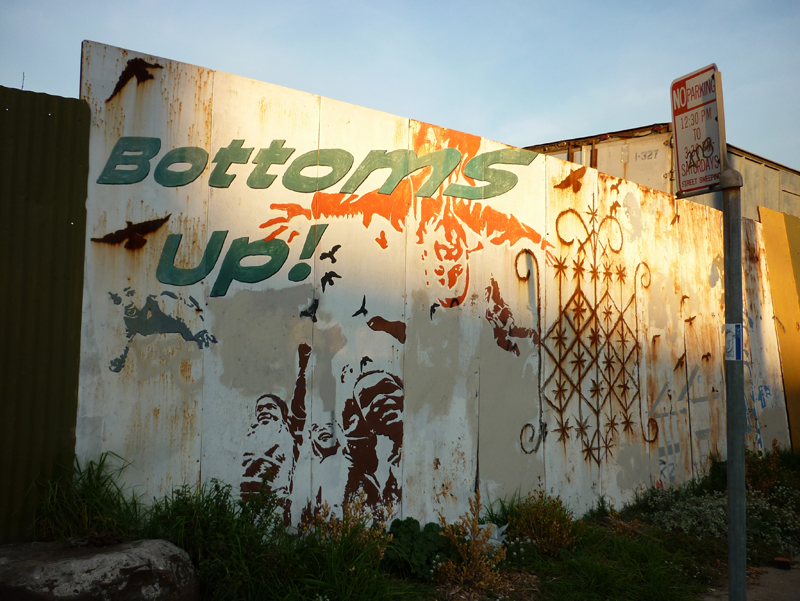
There are some injustices that are so visible and egregious — genocide, slavery, apartheid — that eventually they garner enough attention and outrage to be deemed unacceptable in the public eye, and action is taken to right the wrong. However, while blood, shackles and barbed wire fences are recognizable symbols of oppression and have become unacceptable markers in our collective moral compass, it is much easier to ignore or be oblivious to the more subtle yet pervasive injustices and mental walls that still exist all around us.
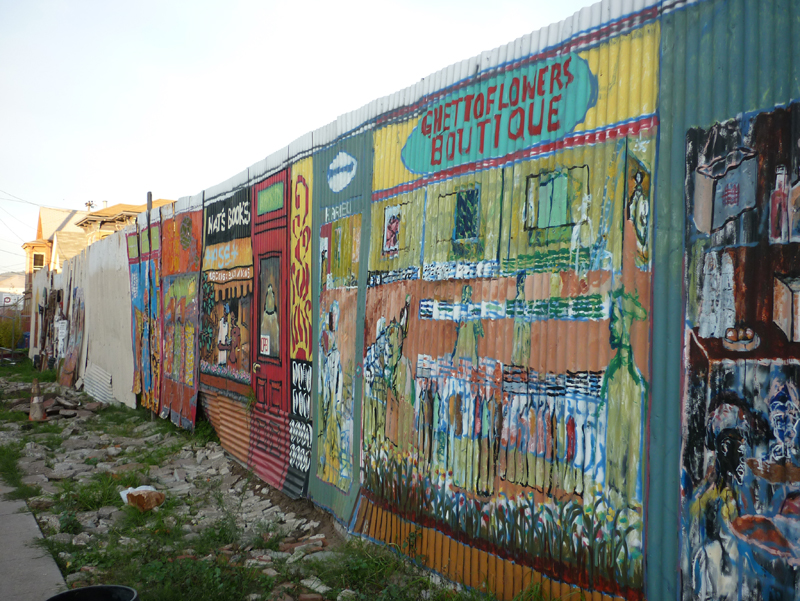
The fact that we're still here is testament to our spiritual resilience.
- Marcel Diallo
Often, the mental barriers persist long after the shackles have been removed. As I described in From the Bottoms Up, in West Oakland they persist through a history of urban planning that builds a highway right through the poorest part of a city and cuts off an entire community from vital services like grocery stores and hospitals. They persist in the form of an economic system that rewards those who already have money and withholds loans from those who don't (unless they're sub-prime). They persist in the form of industries that would never be allowed to build a plant in a white middle class neighborhood with political clout but can buy up cheap land (cheap for them, not for the residents) in a struggling minority neighborhood.
This recycling center was built on Pine Street, the Bottoms' main drag, at the height of West Oakland's decline in the early 1980s, introducing garbage odors and rodents to the neighborhood:

In most places, having the odds stacked against you for so long would eventually mean the end of a community and its deep roots. After the last of the better heeled black residents have moved away to escape the urban blight and property prices drop far below market rates in the area, the land becomes lucrative to developers who will invest in remaking the neighborhood to attract young, upwardly mobile, predominantly white folks looking to fulfill their dream of owning a home that will gain in value as the new community takes hold and flourishes. It's also called gentrification.
You see, nobody gets harassed, shackled, or killed, so nobody is directly responsible for the uprooting. It's like death by a thousand cuts. We're all just fish in a big pond, swimming in the free market waters where some of us eat and others get eaten. End of story. Right?

Wrong.
This is where the story of the Village Bottoms takes a sharp turn from the usual dead end of racial polarization, from the traps of dualistic us-versus-them thinking, where ignorance begets resentment and accusation begets guilt. And who better to break the vicious cycle, to invite us to heal and to overcome, to process without pretense, to remember without getting stuck, than the creative spirits of this world, the artists, musicians and storytellers? Come on in, and tap into your soul truth...

We have to protect the neighborhood with our artistic endeavors.
- Marcel Diallo
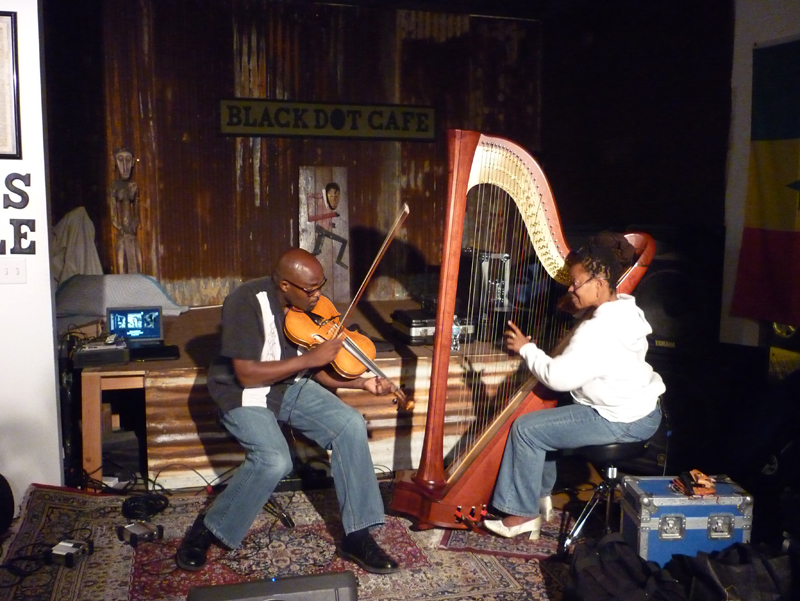
Marcel has a way of drawing you into his world, weaving together a web of personal stories and historic events punctuated by razor-sharp, well-placed epiphanies. One moment he will stand on a fire hydrant in front of the former Phoenix Ironworks, pointing toward the Port of Oakland that blows over all its pollution but none of the unfathomable amounts of money that are changing hands while his community is scraping together the resources to build a Center of Black Folk Life on the huge empty lot...


The next moment we're inside the Black New World Social Aid & Pleasure Club where Marcel proudly recalls how the Bottoms community built this performance space from scratch before he launches into an obituary for black Oakland Blues and Dance Clubs that have been shut down over the years, replaced by white urban lounges.


When I sat for this portrait in 1951, West Oakland was one of the few places we as Black folks were allowed to live. Today I wouldn't leave the Bottoms if they paid me.
- Marcel Diallo's grandmother
The Bottoms community knows they have a long way to go, especially with the economic cards stacked against them. It is not without irony that the same sub-prime loans by predatory lenders that enabled many of them to be home owners in their own neighborhood for the first time just a few years ago took away their ancestors' homes once again during the housing crash. Home values are way down now, but nobody is lending to low income residents.
It's a mixed bag. On the one hand, some of the restoration projects of some of the beautiful original houses have been stalled...

But the seeds that were sown before the housing market crashed are also beginning to sprout now, both figuratively and literally. The old Pacific Cannery is now a state of the art building, offering affordable residential and retail units. Built by developer Rick Holliday who has worked very closely with Marcel and the community in making sure that locals would have first dibs at the spaces, about 20 percent of the residential and most of the retail spaces are currently occupied by African Americans.

There's the above-mentioned Black Dot Cafe, and there's the Juju Shop, a place to immerse yourself into the sights and scents of the African Diaspora, offering everything from books to incense and artifacts...
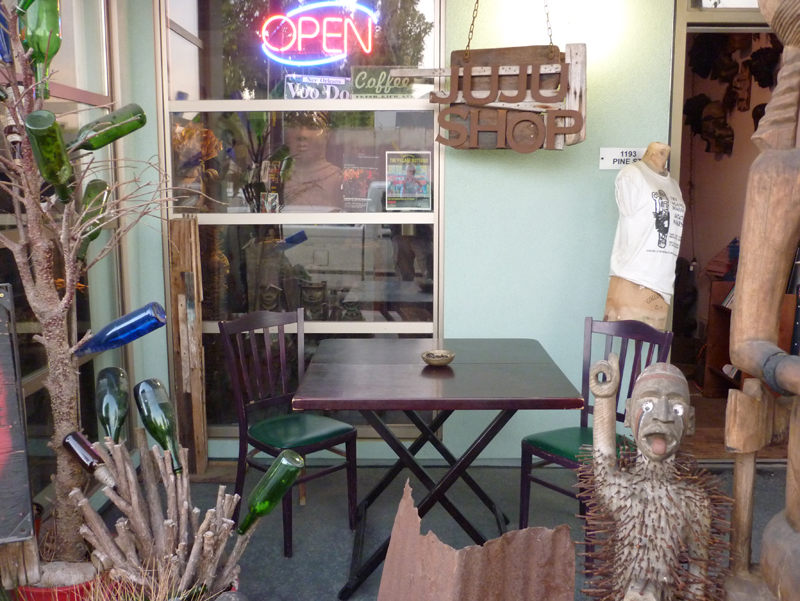
The night of our tour was also the grand opening of the Soul Foods Coop...

The awesome Soul Foods staff was welcoming their first customers with whole foods, healing elixirs, and a profound knowledge of nutrition and its effects on the body's immune system. Here are Yasser and Ian serving up mushroom tea and marrow soup...
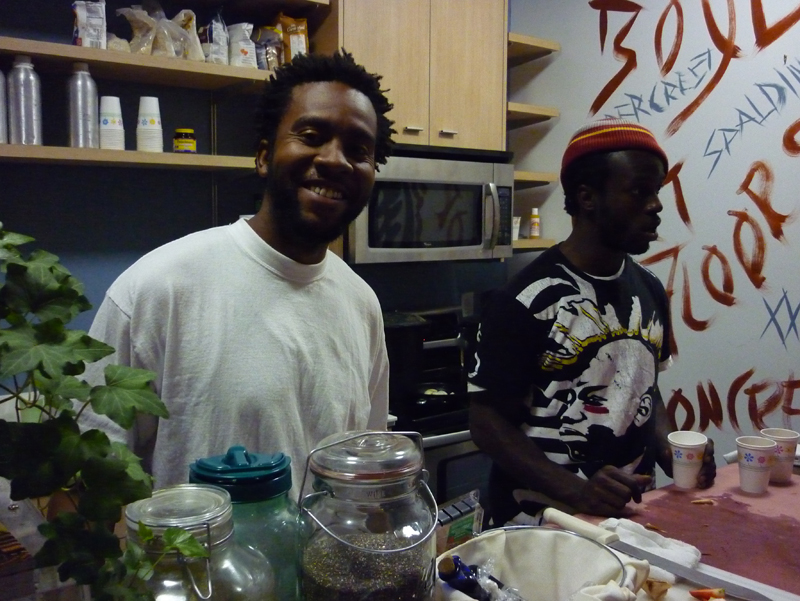
We're trying to change people's perception.
- Marcel Diallo
And yes, food. Up until recently there wasn't a single grocery store in all of West Oakland, but 53 liquor stores! Talk about being at a disadvantage! How can you expect a community to survive, much less thrive, without access to real food? And this went on unnoticed and was tolerated for decades until this group of young visionaries and entrepreneurs got together and decided that in order for the existing dynamics and conditions to change they had to become the change they wished to see. There needed to be a farm in the Village Bottoms.
They spent a year cleaning up an old junk lot that Marcel had bought for a song. Then they took a trip to Wisconsin to meet with basketball player turned urban farm guru turned MacArthur Fellowship recipient Will Allen, to learn worm composting, aquaponics construction and other farm skills. Back home, they built their own aquaponics system, a method of growing crops and fish together on re-circulating raised beds. By the time we got the tour, the operation was up and running...


You get the idea. This is not a community asking for a free handout, a stereotype that often rears its head when a minority group suggests it should get more proportionate access to resources, reversing the cumulative and systemic injustices of the past and creating the semblance of a level playing field. This is also not some sort of a fad, a flaky artist commune that's going to fade away at the first signs of hardship. It's also not a revenge conspiracy to sabotage the hipster dream of owning an affordable home in an up and coming hood. No, this is the call of native people with a deep spiritual connection to the land and a long proud lineage and cultural history to be treated with respect, to have a say in what gets built on their sacred ground, to negotiate on equal terms.
All we want is a little Black Cultural District, like the Chinese have Chinatown, Italians have North Beach, Latinos have the Mission.
- Marcel Diallo
An article in the San Francisco Chronicle by Valerie Fahey just yesterday about the new Pacific Cannery lofts that are now for sale right behind the Central Station demonstrates the mental disconnect and ignorance that still shapes our public discourse:
So far, there are 163 units in the former Pacific Cannery building - about half have been sold - and Zephyr Gate's 130-unit townhouse project. Ninety-nine below-market-rate apartments are in the works for what is known as the Prescott Oakland-Point neighborhood. The area has long been a sort of no-man's-land. West Oakland was cut off from the rest of the city on four sides by the Oakland Army Base, West Oakland BART, the West Grand Avenue freeway entrance to the Bay Bridge and a lumbering double-decker portion of Interstate 880 called the Cypress Structure.
[bold-face mine.]
Not a single mention of Village Bottoms in the entire article. Or I guess it is mentioned once, if you count a sort of no-man's-land as a rough translation. I guess since Ms. Fahey didn't see any men (or women) on her way to the loft opening they must not exist.
A sampling from the comments section gives you a taste of what the Village Bottoms neighborhood is up against: (and remember, this is the "liberal" Bay Area)
- What they really need is a shooting range for the people living there. That way they might have a chance to defend themselves.
- I am sure everyone with no money will be lining up to purchase (and default) on these lovely "homes". Assault rifle included?
- yikes.. west oakland...too close to the scum and druggies that live there.. cant imagine you will get real people there.

It is comments like these that give Marcel Diallo's invitation to come to West Oakland and get a taste of what it means to be black a deeper layer of texture and meaning. It is as if he understands that in order to heal we have to feel both the pain and the joy, in order to evolve we have to remember, and in order to be human we have to experience someone else's humanity. Sometimes the strongest remedies have a bitter taste, but they boost our immune system so that we may once again taste the sweetness.
We are the black dot, but we need that concentric circle of allies surrounding us.
- Marcel Diallo
I, for one, feel extremely fortunate to have been connected with and touched by the fighting and healing spirit of the Village Bottoms. I see their deep love for and connection with their ancestral land as a great benefit to all of us, and by supporting and nurturing their stewardship of roots both physical and cultural we are helping to strengthen and realign one small strand in the fragile web of life we all depend on.

As Marcel says, "We all need an African American Cultural District, just as we all need a Chinatown." We also all need urban communities based on human needs and "access by proximity" rather than cities built in the current pattern of automobile driven excess, wasteful consumption and the destruction of the biosphere. The Village Bottoms represents a great opportunity to use a boundless well of human passion, energy and creativity not only to overcome a history of injustices and the mental barriers associated with it, but to be a model city of the future in which walking, bicycling and gardening are the natural result of a healthy, caring and interconnected community.
As you have read and seen, this is not a Utopian fantasy or a drawing in a sketchbook. With the help of Ecocity Builders, the vision has been laid out and a plan been drafted. Now it is up to the powers that be, both developers and the City of Oakland, to come through with the political and economic will to invest from the bottoms up to lay the foundation for the city of the future. In the meantime, it is up to us to keep breaking down stereotypes and healing old wounds. So come on down to the Bottoms for a cup of tea and a chat — you might end up learning about fish ponds and worm bins!
========
photos by Debra Baida & Sven Eberlein
cross-posted at A World of Words
Resources:
More photos from the Village Bottoms Tour
Part I & II of my Village Bottoms series:
From the Bottoms Up
Don't save us, work with us!
Book: Village Bottoms Cultural District
By Ecocity Builders and Village Bottoms Neighborhood
Marcel Diallo to speak at the 2009 Ecocity World Summit in Istanbul
Please consider supporting projects like the Village Bottoms Farm and the Soul Food Coop by becoming a Friend of the Black New World
 EcoJustice series discuss environmental justice, or the disproportionate impacts on human health and environmental effects on minority communities. All people have a human right to clean, healthy and sustainable communities.
EcoJustice series discuss environmental justice, or the disproportionate impacts on human health and environmental effects on minority communities. All people have a human right to clean, healthy and sustainable communities.
Almost 4 decades ago, the EPA was created partially in response to the public health problems caused in our country by environmental conditions, which included unhealthy air, polluted rivers, unsafe drinking water and waste disposal. Oftentimes, the answer has been to locate factories and other pollution-emitting facilities in poor, culturally diverse, or minority communities.
Please join EcoJustice hosts on Monday evenings at 7PM PDT. Please email deborahphelan@gmail.com if you are interested in hosting.


